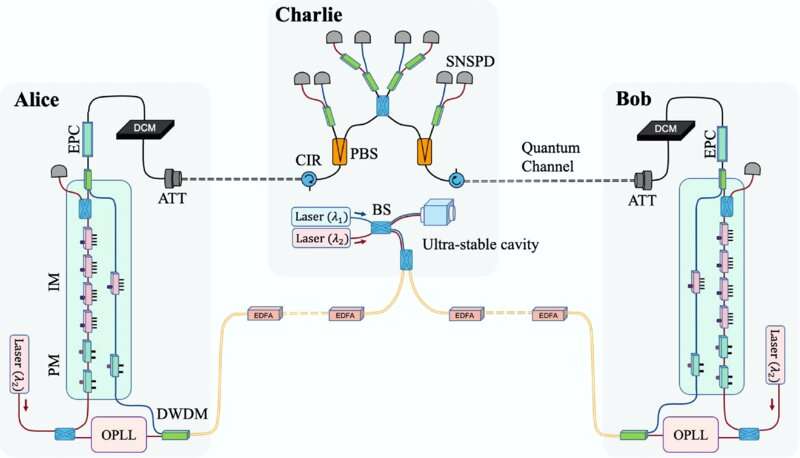Scientists achieve 1,000 km quantum key distribution

A point-to-point long-distance quantum key distribution (QKD) over a distance of 1,002 km has been achieved by scientists from the University of Science and Technology of China (USTC) of the Chinese Academy of Sciences (CAS), and their collaborators from Tsinghua University, Jinan Institute of Quantum Technology, and Shanghai Institute of Microsystem and Information Technology (SIMIT), CAS. This milestone not only sets a new world record for non-relay QKD but also provides a solution for high-speed intercity quantum communication. The results were published in Physical Review Letters on May 25th.
QKD is based on the principles of quantum mechanics and enables secure key distribution between two remote parties. When combined with the “one-time pad” encryption method, it can achieve the highest level of security for confidential communication. However, the distance of QKD has been limited by factors such as the channel loss and system noise.
The twin-field QKD (TF-QKD) using sending-or-not-sending (SNS) protocol was demonstrated in the experiment, improving the relation between the key rate and channel transmittance from a linear η to its square root η. Therefore, it can achieve a much longer secure distance than traditional QKD protocols.
To achieve long-distance QKD, the research team collaborated with Yangtze Optical Fiber and Cable Joint Stock Limited Company (YOFC) and used ultra-low-loss fiber based on pure silica core technology, which achieved a maximum attenuation of 0.16 dB/km. SIMIT developed ultra-low-noise superconducting single-photon detectors.
By implementing multiple filters at temperatures of 40 K and 2.2 K to suppress dark counts caused by thermal radiation, the noise of the single-photon detectors was reduced to around 0.02 cps. Furthermore, the team also developed a dual-band phase estimation scheme to avoid the spontaneous Raman scattering noise, reducing the system noise to below 0.01 Hz.
Based on the aforementioned technological developments, the team achieved TF-QKD over a record distance of 1,002 km, with a key rate of 0.0034 bps. This work not only verifies the feasibility of the SNS-TF-QKD scheme at extremely long distances but also demonstrates that this protocol can achieve high key rates in many practical scenarios.
The success of this study holds significant implications for the advancement of secure quantum communication. It opens up new possibilities for long-distance quantum key distribution and paves the way for the realization of high-speed intercity quantum communication networks.
More information:
Yang Liu et al, Experimental Twin-Field Quantum Key Distribution over 1000 km Fiber Distance, Physical Review Letters (2023). DOI: 10.1103/PhysRevLett.130.210801
Provided by
University of Science and Technology of China
Citation:
Scientists achieve 1,000 km quantum key distribution (2023, June 13)
retrieved 13 June 2023
from https://phys.org/news/2023-06-scientists-km-quantum-key.html
This document is subject to copyright. Apart from any fair dealing for the purpose of private study or research, no
part may be reproduced without the written permission. The content is provided for information purposes only.
For all the latest Science News Click Here
For the latest news and updates, follow us on Google News.

